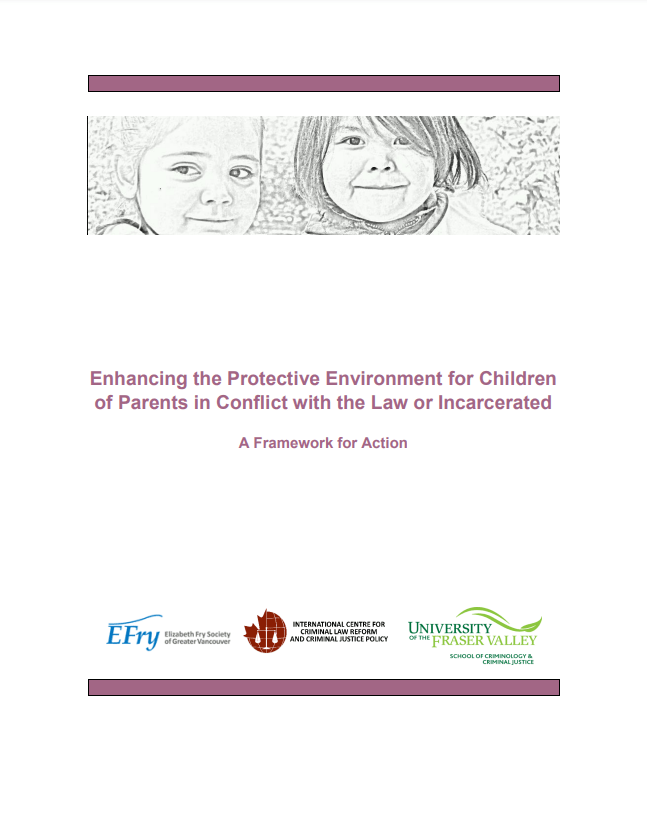4 search results
for
First Nations governments
Practical measures and strategies
Mobilizing the community in order to strengthen the protective environment for the children of incarcerated parents and other parents in conflict with the law
Recommendation 8: Everyone in the community who carries a responsibility for the care, education and protection of children (including but not limited to agencies with a formal mandate) must come together to support these children.-
Category and theme:
Audience:
Groups affected:
Recommendation 9:
Cooperation among health and child welfare services, the police, correctional officials, officials with responsibility for protecting children and their rights, educational institutions, non-governmental organizations offering support to children and their families, faith-based groups, Indigenous councils, and municipal authorities is required. However, there is no need to “reinvent the wheel”. Communities should make the best use of existing resources and coordination mechanisms. They may need to expand participation in these mechanisms in order to include all those who can play a role in helping this particular group of children.
- Make good use of existing coordination mechanisms.
- As necessary, develop interagency protocols or agreements concerning information sharing and case referrals (with adequate protection for privacy and confidentiality).
- Review existing agreements to determine whether they are sufficient to address the situations of children of parents in conflict with the law.
-
Category and theme:
Audience:
Practical measures and strategies
Improving ways of identifying the children in need of assistance without further stigmatizing them
Recommendation 10: Everyone in the community (neighbours, friends of the family, teachers, sports coaches, elders, religious figures, police, etc.) potentially has a role to play in making sure that children affected by their parents’ conflict with the law are identified, assisted, and protected. Relying solely on the children to come forward and ask for assistance is not realistic. Relying on the parents to come forward and seek help for their children is not reliable. Parents often fear the intervention of child protection services. In many instances they already have a history of contacts with these services. Finally, relying on the justice system itself to transmit information to child welfare and protection agencies is not sufficient either.- Proactively seek to identify children in need of assistance, without labelling or stigmatizing them.
- Increase outreach activities to offer support to the children and their caregivers.
- Ensure that people working with or coming in contact with children as part of their professional responsibilities recognize the children’s signs of distress, isolation, need for assistance.
- Improve inter-agency sharing of information concerning the children while protecting their privacy and ensuring the confidentiality of that information.
- Ensure that all agencies and organizations have a proactive child protection policy that acknowledges the particular issues and needs of children who have a key relationship with a parent in conflict with the law.
-
Category and theme:
Audience:
- Academic institutions ,
- Criminal justice system ,
- Faith and cultural groups ,
- First Nations governments ,
- General public ,
- Government of British Columbia ,
- Government of Canada ,
- Indigenous organizations ,
- Municipal governments ,
- Non-profits and community organizations ,
- Provincial and territorial governments (General)
Groups affected:
Practical measures and strategies
Improving information exchange among those who can offer support and assistance to the children
Recommendation 11: One must attempt to facilitate the exchange of information among those agencies, institutions, and services that are able to offer care and assistance to children of parents in conflict with the law. At the same time, the privacy protection measures guiding information exchange must be respected. In that way, organizations are provided with the mandate and capacity to collaborate and share information to provide a continuum of care to the children and their families.- Remove obstacles that hinder outreach activities and the identification of children of parents in conflict with the law by those who can offer them support and assistance. This may involve re-examining, in the light of the principle of the best interests of the child, any privacy and confidentiality protection measure or other factors hindering information exchange and collaboration among and between agencies and significant community resources. For example, the Freedom of Information and Protection of Privacy Act can be upheld through individuals and families controlling access to and disclosure of personal information through informed consent.
- Develop interagency protocols regarding the sharing of information in order to facilitate supportive interventions, or review existing cooperation protocols.
- Ensure that interagency protocols clearly specify the situations in which a guardian’s or a family’s permission to share information is not required, for example when there are child and adult protection issues.
-
Category and theme:
Audience:
Groups affected:
